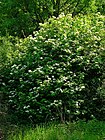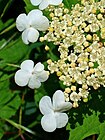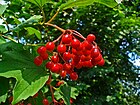Note: This is a project under development. The articles on this wiki are just being initiated and broadly incomplete. You can Help creating new pages.
Difference between revisions of "Viburnum opulus - Guelder Rose"
(→Flower) |
|||
| (5 intermediate revisions by 2 users not shown) | |||
| Line 1: | Line 1: | ||
[[File:Viburnum opulus.jpg|thumb|right|''Guelder-rose'', ''Viburnum opulus'']] | [[File:Viburnum opulus.jpg|thumb|right|''Guelder-rose'', ''Viburnum opulus'']] | ||
| − | '''Viburnum opulus''' is a species of flowering plant in the family Adoxaceae | + | '''Viburnum opulus''' is a species of flowering plant in the family Adoxaceae. It is native to Europe, northern Africa and central Asia. |
| − | |||
==Uses== | ==Uses== | ||
| − | {{Uses|Fluid retention}}, {{Uses|Eye disorders}}, {{Uses|Menstrual cramps}}, {{Uses|Cramps during pregnancy}}, {{Uses|Scurvy}}, {{Uses|Hysteria}}, {{Uses|Infection}}, {{Uses|Diarrhea}}, {{Uses|Nervous disorders}} | + | {{Uses|Fluid retention}}, {{Uses|Eye disorders}}, {{Uses|Menstrual cramps}}, {{Uses|Cramps during pregnancy}}, {{Uses|Scurvy}}, {{Uses|Hysteria}}, {{Uses|Infection}}, {{Uses|Diarrhea}}, {{Uses|Nervous disorders}}. |
==Parts Used== | ==Parts Used== | ||
| Line 9: | Line 8: | ||
==Chemical Composition== | ==Chemical Composition== | ||
| − | The berries of V. Opulus contain valerianic acid (Dumas; phocenic acid of Chevreul, identical with the volatile acid from the fat of the dolphin) | + | The berries of V. Opulus contain valerianic acid (Dumas; phocenic acid of Chevreul, identical with the volatile acid from the fat of the dolphin) and a red coloring matter etc.<ref name="chemical composition"/> |
==Common names== | ==Common names== | ||
| − | {{Common names|kn=|ml=|sa=|ta=|te=|hi=|en=Snowball Tree, European Craneberry }} | + | {{Common names|kn=|ml=|sa=|ta=|te=|hi=|en=Snowball Tree, European Craneberry}} |
==Properties== | ==Properties== | ||
| Line 35: | Line 34: | ||
==Identification== | ==Identification== | ||
===Leaf=== | ===Leaf=== | ||
| − | {{Leaf|Simple| | + | {{Leaf|Simple|Opposite|Simple, broad and three-lobed with coarse, serrated edges and sparse fine hairs on the underside}}<ref name="Leaf"/> |
===Flower=== | ===Flower=== | ||
| − | {{Flower|Bisexual|2-4cm long| | + | {{Flower|Bisexual|2-4cm long|Creamy-white|5-20|Flat-topped flowers appear in May to July}} |
===Fruit=== | ===Fruit=== | ||
| − | {{Fruit|Round|7–10 mm (0.28–0.4 in.) long pome|Bright red berries appear in autumn in hanging bunches| | + | {{Fruit|Round|7–10 mm (0.28–0.4 in.) long pome|Bright red berries appear in autumn in hanging bunches|Translucent flowers|-}} |
===Other features=== | ===Other features=== | ||
==List of Ayurvedic medicine in which the herb is used== | ==List of Ayurvedic medicine in which the herb is used== | ||
| − | |||
==Where to get the saplings== | ==Where to get the saplings== | ||
| Line 53: | Line 51: | ||
==How to plant/cultivate== | ==How to plant/cultivate== | ||
| − | Landscape Uses:Border, Massing, Screen, Specimen. An easily grown plant, it succeeds in most soils but is ill-adapted for poor soils and for dry situations[1]. It prefers a deep rich moist loamy soil in a sunny position<ref name="How to plant/cultivate"/> | + | Landscape Uses:Border, Massing, Screen, Specimen. An easily grown plant, it succeeds in most soils but is ill-adapted for poor soils and for dry situations[1]. It prefers a deep rich moist loamy soil in a sunny position.<ref name="How to plant/cultivate"/> |
==Commonly seen growing in areas== | ==Commonly seen growing in areas== | ||
| − | {{Commonly seen| | + | {{Commonly seen|Scrub and woodland}}, {{Commonly seen|Hedges}}, {{Commonly seen|Damp soils}}. |
==Photo Gallery== | ==Photo Gallery== | ||
| Line 73: | Line 71: | ||
<references> | <references> | ||
| − | <ref name="chemical composition">[https://www.henriettes-herb.com/eclectic/kings/viburnum-opul.html | + | <ref name="chemical composition">[https://www.henriettes-herb.com/eclectic/kings/viburnum-opul.html Chemical constituents]</ref> |
| − | <ref name="Leaf">[https://www.woodlandtrust.org.uk/visiting-woods/trees-woods-and-wildlife/british-trees/native-trees/guelder-rose/ | + | <ref name="Leaf">[https://www.woodlandtrust.org.uk/visiting-woods/trees-woods-and-wildlife/british-trees/native-trees/guelder-rose/ Plant description]</ref> |
| − | <ref name="How to plant/cultivate">[https://www.pfaf.org/user/Plant.aspx?LatinName=viburnum+opulus | + | <ref name="How to plant/cultivate">[https://www.pfaf.org/user/Plant.aspx?LatinName=viburnum+opulus Cultivation details]</ref> |
</references> | </references> | ||
==External Links== | ==External Links== | ||
| − | * [https://www.plantopedia.com/viburnum-opulus/ ] | + | * [https://www.plantopedia.com/viburnum-opulus/ Viburnum opulus on plantopedia.com] |
| − | * [https://www.researchgate.net/publication/279578235_Chemical_composition_and_antimicrobial_activities_of_the_essential_oils_of_Viburnum_opulus_Viburnum_lantana_and_Viburnum_orientala Chemical composition and antimicrobial activities of the essential oils of Viburnum opulus] | + | * [https://www.researchgate.net/publication/279578235_Chemical_composition_and_antimicrobial_activities_of_the_essential_oils_of_Viburnum_opulus_Viburnum_lantana_and_Viburnum_orientala Chemical composition and antimicrobial activities of the essential oils of Viburnum opulus Viburnum opulus on researchgate.net] |
| − | * [https://www.ncbi.nlm.nih.gov/pubmed/23993538 Antioxidant properties and polyphenolic compositions of fruits from different European cranberrybush] | + | * [https://www.ncbi.nlm.nih.gov/pubmed/23993538 Antioxidant properties and polyphenolic compositions of fruits from different European cranberrybush Viburnum opulus on Ncbi.nlm.nih.gov] |
[[Category:Herbs]] | [[Category:Herbs]] | ||
[[Category:Adoxaceae]] | [[Category:Adoxaceae]] | ||
Latest revision as of 20:59, 1 September 2020
Viburnum opulus is a species of flowering plant in the family Adoxaceae. It is native to Europe, northern Africa and central Asia.
Contents
- 1 Uses
- 2 Parts Used
- 3 Chemical Composition
- 4 Common names
- 5 Properties
- 6 Habit
- 7 Identification
- 8 List of Ayurvedic medicine in which the herb is used
- 9 Where to get the saplings
- 10 Mode of Propagation
- 11 How to plant/cultivate
- 12 Commonly seen growing in areas
- 13 Photo Gallery
- 14 References
- 15 External Links
Uses
Fluid retention, Eye disorders, Menstrual cramps, Cramps during pregnancy, Scurvy, Hysteria, Infection, Diarrhea, Nervous disorders.
Parts Used
Chemical Composition
The berries of V. Opulus contain valerianic acid (Dumas; phocenic acid of Chevreul, identical with the volatile acid from the fat of the dolphin) and a red coloring matter etc.[1]
Common names
| Language | Common name |
|---|---|
| Kannada | |
| Hindi | |
| Malayalam | |
| Tamil | |
| Telugu | |
| Marathi | NA |
| Gujarathi | NA |
| Punjabi | NA |
| Kashmiri | NA |
| Sanskrit | |
| English | Snowball Tree, European Craneberry |
Properties
Reference: Dravya - Substance, Rasa - Taste, Guna - Qualities, Veerya - Potency, Vipaka - Post-digesion effect, Karma - Pharmacological activity, Prabhava - Therepeutics.
Dravya
Rasa
Tikta (Bitter), Kashaya (Astringent)
Guna
Laghu (Light), Ruksha (Dry), Tikshna (Sharp)
Veerya
Ushna (Hot)
Vipaka
Katu (Pungent)
Karma
Kapha, Vata
Prabhava
Habit
Identification
Leaf
| Kind | Shape | Feature |
|---|---|---|
| Simple | Opposite | Simple, broad and three-lobed with coarse, serrated edges and sparse fine hairs on the underside |
Flower
| Type | Size | Color and composition | Stamen | More information |
|---|---|---|---|---|
| Bisexual | 2-4cm long | Creamy-white | 5-20 | Flat-topped flowers appear in May to July |
Fruit
| Type | Size | Mass | Appearance | Seeds | More information |
|---|---|---|---|---|---|
| Round | 7–10 mm (0.28–0.4 in.) long pome | Bright red berries appear in autumn in hanging bunches | Translucent flowers | - | {{{6}}} |
Other features
List of Ayurvedic medicine in which the herb is used
Where to get the saplings
Mode of Propagation
How to plant/cultivate
Landscape Uses:Border, Massing, Screen, Specimen. An easily grown plant, it succeeds in most soils but is ill-adapted for poor soils and for dry situations[1]. It prefers a deep rich moist loamy soil in a sunny position.[3]
Commonly seen growing in areas
Scrub and woodland, Hedges, Damp soils.
Photo Gallery
References
External Links
- Ayurvedic Herbs known to be helpful to treat Fluid retention
- Ayurvedic Herbs known to be helpful to treat Eye disorders
- Ayurvedic Herbs known to be helpful to treat Menstrual cramps
- Ayurvedic Herbs known to be helpful to treat Cramps during pregnancy
- Ayurvedic Herbs known to be helpful to treat Scurvy
- Ayurvedic Herbs known to be helpful to treat Hysteria
- Ayurvedic Herbs known to be helpful to treat Infection
- Ayurvedic Herbs known to be helpful to treat Diarrhea
- Ayurvedic Herbs known to be helpful to treat Nervous disorders
- Herbs with Fruits used in medicine
- Herbs with common name in English
- Habit - Deciduous Shrub
- Index of Plants which can be propagated by Seeds
- Index of Plants which can be propagated by Layering
- Herbs that are commonly seen in the region of Scrub and woodland
- Herbs that are commonly seen in the region of Hedges
- Herbs that are commonly seen in the region of Damp soils
- Herbs
- Adoxaceae








